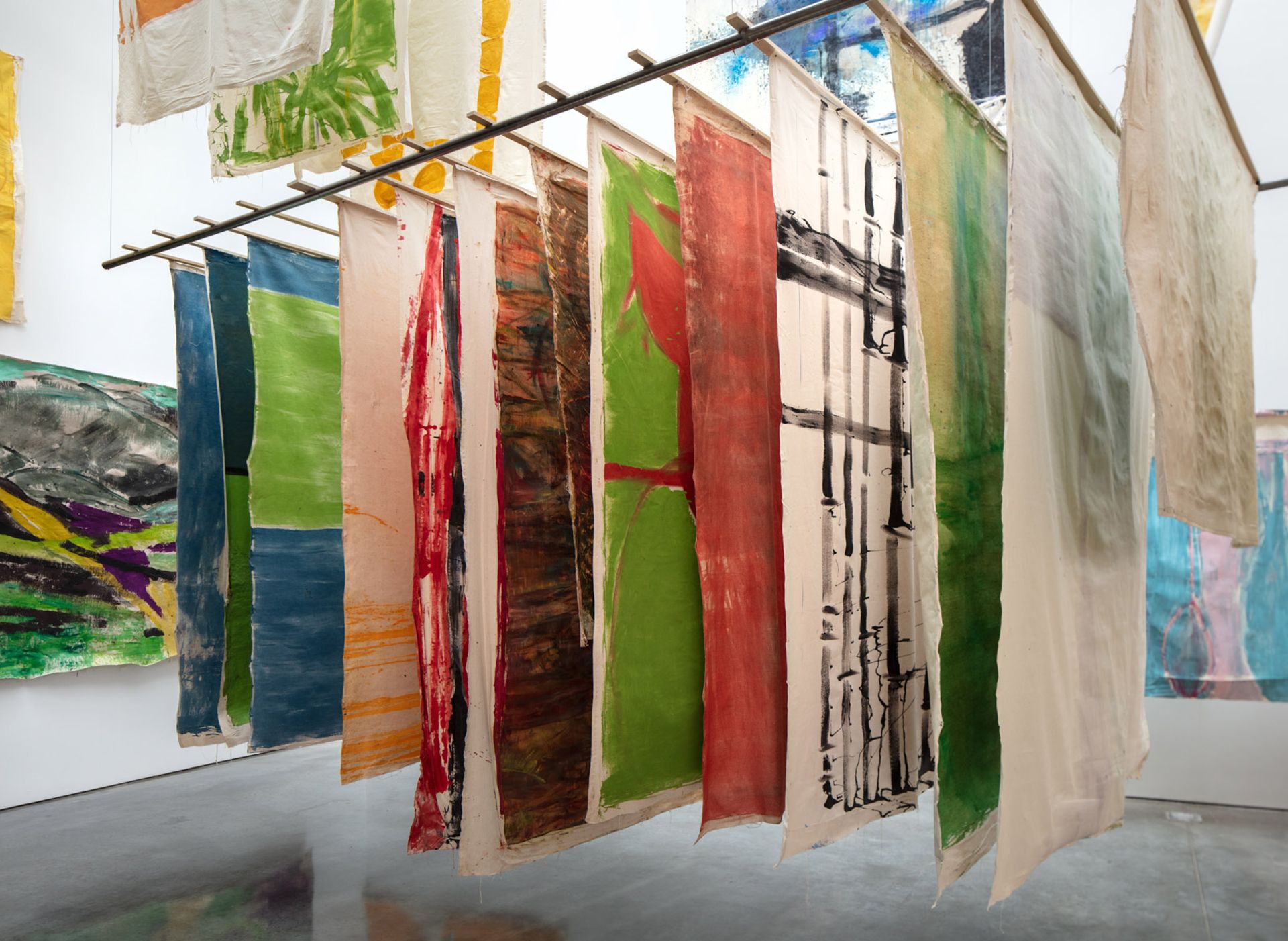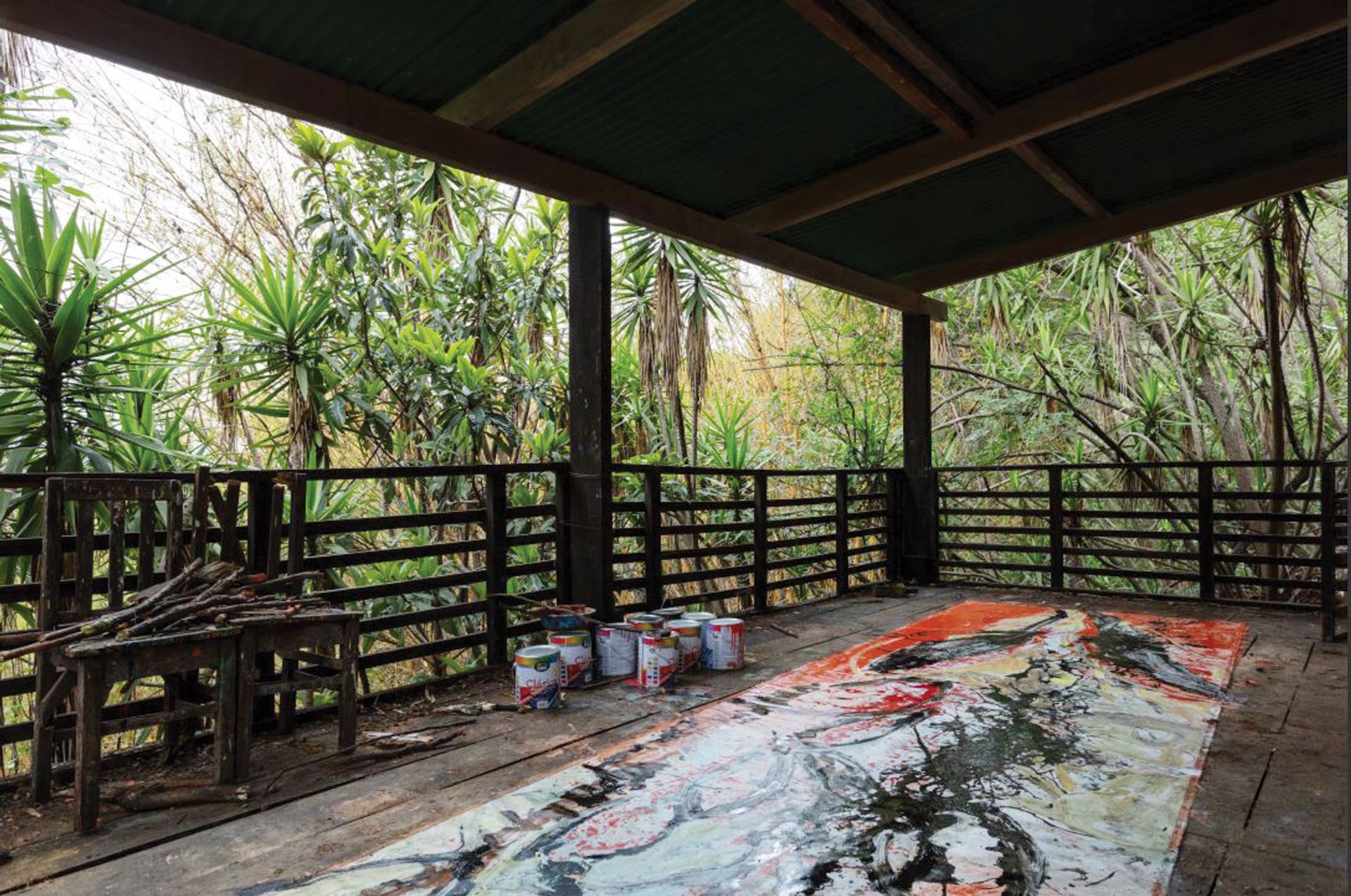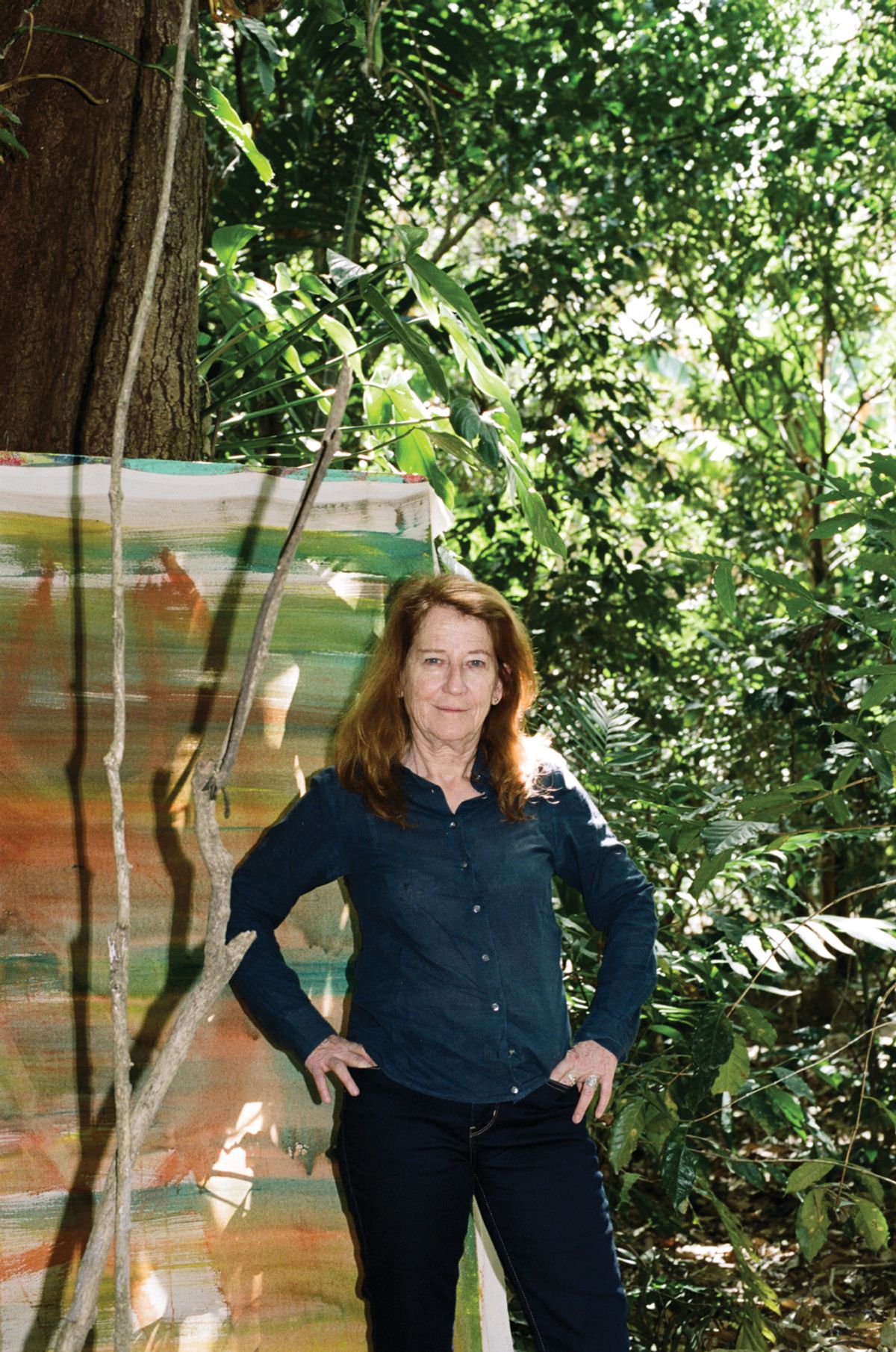In 1983 Argentinian-born Vivian Suter left behind the beginnings of a promising career as an abstract painter in Basel, Switzerland when she moved to the small town of Panajachel in rural Guatemala. She has lived and worked there ever since, building a house and two studios in tropical rainforest beside a volcanic lake. It was only in 2011, when Adam Szymczyk, then the director of Kunsthalle Basel, decided to make an updated version of a 1981 group painting exhibition that she was rediscovered by the art world. Szymczyk went on to champion her work, notably by including two installations of Suter’s abstract paintings in Kassel and Athens for Documenta 14 in 2017. A number of exhibitions across Europe and the US then followed, most recently on New York’s High Line, where Xocomil, her outdoor display of 20 canvases, continues until March 2020. Now the 70-year-old artist has her first UK exhibition at Tate Liverpool where she is showing Nisyros (Vivian’s Bed) (2016-17), the 53 suspended and floor-bound canvases first shown at Kassel in 2017. In January a substantial show of work, old and new, opens at Camden Arts Centre, and later in the year she will have a retrospective at the Reina Sofía in Madrid. Suter’s first public work in the UK opens at Stratford Underground station in June 2020.
The Art Newspaper: You have described your paintings as “depicting, interpreting and commenting on my outer and inner surroundings”. Where and how are they made?
Vivian Suter: I like to paint them outside, up on the mountain. My top studio is there, above the treetops. I have my paints there and I feel disconnected from everything below. Sometimes I work down in the garden. I always work outside with the paintings on stretchers propped up against trees or walls. I also have paintings on the floor where there are leaves and sticks and the dogs often walk on them. Sometimes I bury them or leave them in the wind and rain. When the paintings are finished, I take them off their stretchers, dry them and put them inside, nicely on the hanging rack, one behind the other. Sometimes I also show them on a similar hanging structure.
Why do you work outside?
It’s important to be outside so that when I’m making my work it absorbs its surroundings. I want to give the feeling of being in the environment here with my paintings. When I’m working, I try to plan as little as possible; I want to get into the painting itself and for the picture to show itself to me. I mix the paint with rainwater, mud and fish glue; I used to just put the glue on top of the canvas to make it tight but now I also mix it into the colours. I love the patterns this makes when it rains, and that with rainwater it can grow mould. I always try to be surprised at what comes out; that’s the interesting part and what keeps me going.

Vivian Suter’s studio in Guatemala © Vivian Suter; courtesy of the artist and Gladstone Gallery
In 2005 you had the traumatic experience of a severe tropical storm, Hurricane Stan, flooding your studio. How did this affect your work?
It was devastating to open up the studio and suddenly find almost a metre of mud and water in there and the paintings on the floor. Those that had been stacked on the floor were swimming around, and those on the hanging structures looking terrible, marked with a straight line of mud through them. But when I cleaned out the mud from the studio and the paintings started to dry, I saw a beauty in the way that nature had helped me to unify the work through this mud. Suddenly, after this catastrophe, the paintings got another life and I got a different way of thinking and painting and having nature work with me.
Why do you paint on stretchers but exhibit your works hanging free?
I love the tension between the precision of working on a stretched canvas and then how the paintings get their own life when I unstretch them. They move around in the wind and become more like objects.
Nisyros (Vivian’s Bed) and what you are planning for the Camden show are entire immersive environments made up of many paintings. Why do you show your work in this way?
I want to create the feeling of being in Guatemala. It is also important, especially if I show them on the rack structures, that the paintings are not just paintings but they can also be like a sculpture. The layers look so great—like hiding and then showing, or not showing and making things mysterious. At Tate Liverpool, the whole room will be sculptural; I hope they let you touch them.

Installation view of Vivian Suter at Gladstone Gallery, New York Photo: David Regen
In the late 1970s and early 1980s you enjoyed success in Basel and beyond, but you chose to leave and ended up in Guatemala. Why did you turn your back on the art world?
The social part, having to go to openings, was too intense for me. I also got divorced. I wanted to concentrate more on my work and to go as far as possible with it. I first went to Los Angeles but I didn’t like it there and so I decided to go to Mexico and look at all the ruins. Then I kept going on and on, and I landed in Guatemala. I found a place to stay by the lake—a different one to where I live now—and I also fell in love. Then my son was born here in this little town of Panajachel. But none of this was planned at all.
You’ve remained in Guatemala for more than 30 years. What makes you stay?
When I got this land there was already a coffee plantation here and it had many trees, but I kept planting and planting and creating this garden. Now I spend a lot of time looking at the plants and how they grow. It is a beautiful country and the atmosphere here is very inspiring.
Your mother, Elisabeth Wild, is also an artist, and in 1997 she came from Switzerland to live near you in Guatemala. How much of an inspiration has she been?
From when I was a child, I always saw my mother painting and working, and she is still a very important inspiration for me. She lives beside me but not in the same house. She can’t see my things because she is in a wheelchair and cannot get out. But I also don’t like to show her what I am doing because she is very critical and I get upset. I always discuss her collages with her but I don’t let her discuss my paintings.

Vivian Suter's studio Courtesy the artist and Gladstone Gallery; New York and Brussels; Photography by David Regen
You currently have 20 paintings installed on the High Line in New York that will remain exposed to the elements until March. Why did you decide to do this?
I can learn from how the paintings change and I like not to give importance to this idea that nothing can be allowed to touch them. I am getting reports that they are doing very well, which is astonishing with all that wind and rain. Their title, Xocomil, means “the wind that carries away sin”. In Camden, I will also show some works outside in the garden and, if I have time, I will also make a work there, in the garden and for the garden. I have brought some rubber from the rubber tree and I want to try this out for the garden works, instead of using fish glue. For Stratford Underground station I also want to hang canvases outside, off the architecture. I have had special huge stretchers made and I am just starting work on them. Right now I have canvases and stretchers all over the garden that are waiting for me to paint them.
After working in isolation for more than 30 years, how does it feel to be back at the centre of the art world?
It is very exciting. I hid away but people came and found me; now I can show my work and it is very rewarding. But I also know that I can leave and come back to work here, and that’s the big difference.
Biography
Born: 1948, Buenos Aires
Training: Kunstgewerbeschule Basel, Switzerland, 1972
Key shows: Institute of Contemporary Art, Boston (2019); The Power Plant, Toronto (2018); Taipei Biennial (2018); Documenta 14, Athens and Kassel (2017); Jewish Museum, New York (2017); Kunsthalle Basel, with Elisabeth Wild (2014); 31st São Paulo Biennial (2014); Kunsthalle Basel (2011); Kunstmuseum Thurgau, Switzerland (1983); Kunsthalle Basel group show (1981); Galerie Stampa, Basel (1971)
Represented by: Barbara Gladstone, Brussels, New York; Karma International, Los Angeles, Zurich; Gaga, Mexico City, Los Angeles; Proyectos Ultravioleta, Guatemala
• Vivian Suter’s paintings are part of En Plein Air at the High Line, New York, until March 2020; Vivian Suter, Tate Liverpool, Liverpool, UK, 13 December-15 March 2020; Vivian Suter, Camden Arts Centre, London, 16 January-5 April 2020


